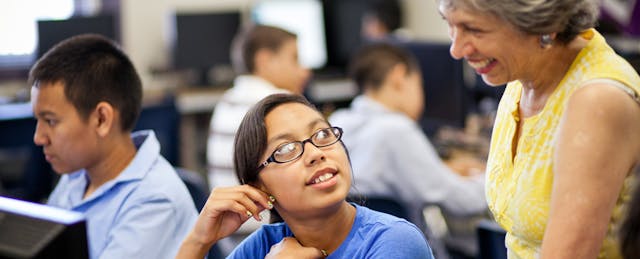The ecology of our children’s educational world is rapidly changing. Toddlers are watching videos and playing computer games. Preschoolers are learning creative writing and doodling digitally long before they use paper. Middle- and high-school kids are more excited about mobile apps than they are about textbooks.
The prevalence of digital technology only underscores why everyone must be literate in computer systems. Increasingly, everything we do is tied to them—from reading the news and purchasing groceries, to communicating with our families, to teaching and learning, to being active in the community.
Parents know this well—especially those who work in the media, technology sector, or government. Since 2009, when President Obama launched the “Educate to Innovate” campaign, he and Secretary of Education, Arne Duncan, have worked to bring STEM to the forefront of the nation's education dialogue.
The administration understands that STEM and computing skills are a necessity for all citizens to ensure that everyone is a digital participation in our democracy and that America’s workforce remains competitive in the digital innovation economy. Still, it will take many cross-sector partnerships to achieve comprehensive implementation of STEM learning opportunities for ALL of America's 150 million K-16 students.
But there’s one crucial player who can help us achieve this vision faster, and instill an appreciation and appetite for computer science in the next generation of kids: parents.
Some schools teach coding in after-school clubs, one-off Saturday programs, or elective computing classes. But coding should not be an extracurricular afterthought. Nor should it be a perk available only to students in affluent zip codes; it must be available to everyone, regardless of age, geography or socioeconomic status. The only way to achieve this level of curriculum penetration is through a national shift in parenting.
As with reading, writing, and math, exposure to coding from an early age will yield deeper fluency and appreciation. We all read to our children from a young age and encourage them to write. We do not expect them to become novelists or journalists, but we know these skills are a pathway to productivity and prosperity. It’s the same with coding. We must commit as parents to raising children who can read, write, and think creatively with this language, for their own future and that of our nation.
Much as we try to model healthy eating habits and daily reading routines, parents must also practice what they preach when it comes to STEM skills. That is why I call on all parents to get smarter about coding in their own right. It’s time for parents to make the leap and learn computing—no matter how daunting or intimidating it may seem.
It's like learning any foreign language—easier when you’re young. But it’s never too late to learn. As parents we know that it is possible, and it can help us understand the landscapes and cultures of the global innovation world our children must one day lead.
In fact, over the years, many parents of Globaloria students have shown an interest in doing the courses their kids are doing. They see clearly that inventing, designing, coding, and engineering a creative video game is a powerful way to teach computer science and other subjects simultaneously. And they’re eager to learn the same way their kids do. The 800 adults -- teachers and education leaders -- we’ve taught, trained, and surveyed over the years reported that it was both fun and valuable to learn the same new language their kids are learning.
Inspired by this swelling interest, Globaloria is now taking STEM education to the next level. We have partnered with The Tech Museum in San Jose, CA to create the first-ever computer coding courses for parents and grandparents. It means these generations can share this learning experience with their kids. And as they learn what we believe today’s kids need to learn, we hope they will be inspired to become advocates for STEM and coding for all kids.
Our approach to teaching coding to parents and grandparents is no different from the way we teach the kids—learning by doing.
Learn to code on your own, and then explore it further with your children. It’ll be an invaluable experience not just for the sake of coding itself, but to help you better understand the changes that need to happen at at the educational, and legislative levels. As voters, we must demand that our system provides all students the opportunity to learn STEM and computing in all 132,000 schools throughout the nation.
Coding is the new literacy. It will be the common language that transcends geographic borders, enabling collaboration, creative storytelling, and knowledge sharing. Making sure that all our children are ready and equipped with the skills to thrive in a new world, though, starts with you.


